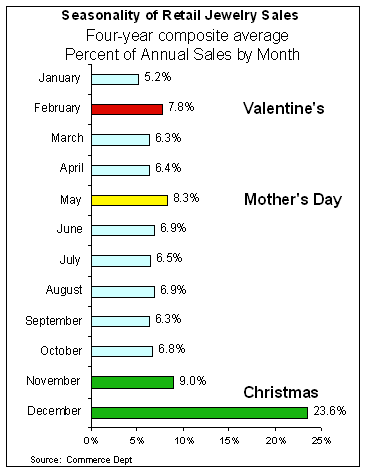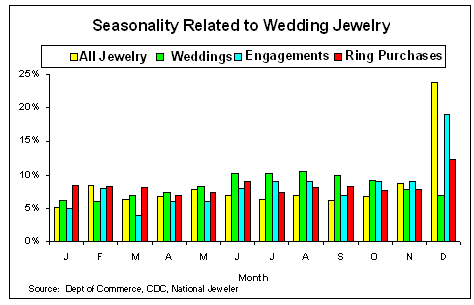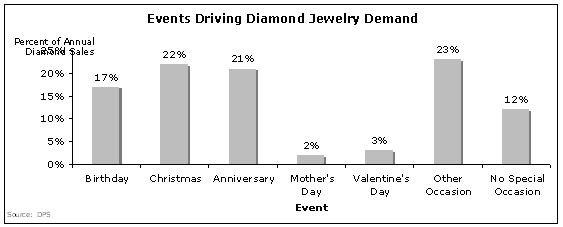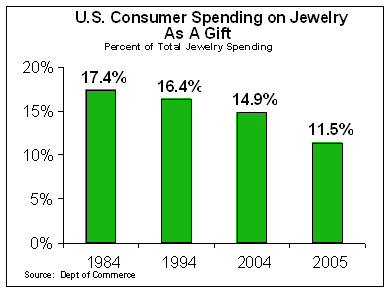Jewelry: Key Events Driving Demand in the U.S. Market
October 07, 07
By Ken Gassman
Retail sales are driven by events: calendar events, life cycle events, and even invented events.
While some retail merchants enjoy consistent consumer demand – stores selling groceries, for example – these retailers can also benefit from “special events” that drive incremental demand. For example, the Christmas selling period in the U.S. drives significant demand for seasonal goods such as fruit cakes, candy canes and other festive goodies in November and December.
Storekeepers such as jewelers, who rely on discretionary spending and impulse buying, are highly dependant on “special events” to drive consumer demand. While some shoppers would argue that jewelry is a necessity, people really can live without jewelry. Maslow’s Hierarchy of Needs suggests that everything beyond food, clothing and shelter is discretionary in today’s society.
Besides “key events” driving jewelry and diamond demand, there are other drivers of demand such as “self-purchase,” but these are random and are triggered by a different set of factors unrelated to calendar and life cycle events.
Major Events Driving Jewelry Demand
For jewelers, there are three categories of events that typically drive their sales: 1) annual calendar events such as Valentine’s Day; 2) life cycle events such as weddings, anniversaries; and, 3) special events such as trunk shows.
Annual Calendar Events
There are three major annual events that drive incremental jewelry demand in the U.S. market:
- Holiday Season – Christmas, Chanukah and Kwanzaa, all of which occur in the November-December period, are by far the most important annual events driving demand for jewelers. During the two-month November and December period (one sixth of the total selling days in a year), a typical U.S. jeweler will generate about one-third of their annual sales. The average price point for holiday jewelry sales is in the $300-$400 range for mass market jewelers and well over $1,000 for guild jewelers.
- Valentine’s Day – Valentine’s Day, which occurs each year on February 14, is the second largest selling event for jewelry in the U.S. market. However, it is a distant second, when compared to the importance of the November-December holiday period. In part, while customer traffic may be intense for jewelers during the two weeks prior to Valentine’s day, the average price point is around $100 for mass market jewelers and $300-$500 for guild jewelers. Thus, while the traffic count may be high, and unit sales strong, total dollars through the cash register are much more modest than during the holiday selling season.
- Mother’s Day – Mother’s Day, which occurs on the second Sunday in May, is the third largest selling event for jewelers in America. Total sales volume for Mother’s Day is nearly as great as for Valentine’s Day, despite an average ticket of just under $100 for mass market jewelers and $200-$400 for guild jewelers. Recent sales trends suggest that Mother’s Day is becoming less important for jewelers than in past years.
- Other Calendar Events – Some jewelers have tried to create jewelry demand around other calendar events such as Memorial Day (late May), Labor Day (early September) and other calendar events. However, these efforts to drive incremental jewelry sales by association with other calendar events have been unsuccessful.
The graph below summarizes the proportion of total annual jewelry sales by month in the U.S. market.
 |
Life Cycle Events
There are several life cycle events driving jewelry demand in the U.S. market. In many cases, these life cycle events have specific jewelry items associated with them. For example, more than 80 percent of all U.S. brides receive a diamond engagement ring.
The most important life cycle events for jewelers include the following:
Wedding / Bridal – Bridal-related jewelry is by far the most important segment of most jewelers’ business.
Mass market jewelers such as Zale and Kay say that roughly 40 percent of their sales are bridal-related merchandise, including diamond engagement rings and wedding bands as well as jewelry for gifts to bridesmaids and groomsmen.
The bridal market represents a steady, stable, consistent market for jewelers. In 2006, the average ticket for a diamond engagement ring in the U.S. market was about $3,250, dramatically above the typical jeweler’s
 |
As the graph above illustrates, engagements, weddings, and ring purchases are remarkably consistent by month throughout the year. The only spike occurs in December, when ring purchases rise; that correlates a sharp increase in the number of engagements.
However, bridal jewelry sales are much more stable across the year than total jewelry sales, as the graph illustrates, especially in December.
In addition to engagement rings, the Diamond Promotion Service says that 52 percent of all brides (and some grooms) received a diamond wedding band in 2006. The average ticket for a diamond wedding band is about $1,450 in the U.S. market.
- Anniversaries – Wedding anniversaries are an important occasion for jewelers, since many men give their wives jewelry to mark their wedding anniversary. With the projected increase in the number of weddings, coupled with a modestly declining divorce rate, the number of wedding anniversaries in the U.S. should rise significantly over the next decade.
Thus, jewelers should benefit from this trend. According to the Diamond Promotion Service, the top three diamond jewelry choices which consumers purchase to mark a wedding anniversary are: 1) diamond studs; 2) necklaces; and, 3) three-stone (Past Present Future) rings. The average ticket for diamond jewelry purchased to commemorate a wedding anniversary was $1,200 in 2006.
- Other Life Cycle Events – There are many other life cycle events that trigger demand for jewelry. For example, a child’s first communion or other religious- related event is often marked with a piece of jewelry, including pearls (for girls) or a watch (for boys). The birth of a child is often marked with a piece of jewelry.
When a young man or young woman graduates from college, they are often given a fine watch that will become a family heirloom over the years.
The graph below illustrates events that drive diamond jewelry sales. The bars represent the percentage of total annual diamond jewelry sales generated by that particular event. For example, sales of diamond anniversary jewelry generate about 21 percent of a typical jeweler’s total annual diamond sales. This data is from the U.S. based Diamond Promotion Service.
 |
Invented Events
Like most good merchants, jewelers have a whole repertoire of “invented” events, including things like a Trunk Show, Midnight Madness Sale, and The Manager’s Gone So We Can Give It Away Sale. While some of these events detract from the professionalism that normally marks the jewelry industry (Midnight Madness sounds like something that was invented by a used car dealer), the point is this: retailing is event-driven, so the more events a jeweler can create, the more likely incremental sales will rise.
Gift-Giving Drives Jewelry Demand
While giving jewelry as a gift has long been a tradition, new data reveals that American consumers have cut back on their gift giving of jewelry. In 2005 (the latest data available), about 11.5 percent of consumers’ jewelry budget was devoted to jewelry as a gift, down from the prior year’s 14.9 percent.
Unfortunately, jewelry as a gift has been falling for the past two decades. For example, in 1984, consumers spent more than 17 percent of their jewelry budget on jewelry as a gift for someone.
Finally, total expenditures for jewelry as a gift in 2005 fell to about $57 per American household, a 22 percent decline from 2004’s $73 per household.
 |
The graph indicates the percentage of their jewelry budgets that Americans are devoting to jewelry as a gift.
Jewelers: Seize The Day
American shoppers go to the grocery store several times a week. Grocers know that they have many opportunities to market certain products to their customers; if those shoppers don’t buy the promoted merchandise today, they may buy it tomorrow.
Unfortunately, jewelers don’t have the same opportunity. Jewelry shoppers, even the most ardent
Even anniversaries and birthdays are no longer a sure bet for a trip to the jewelry store by shoppers; there are too many alternatives vying for their money.
Based on data from the U.S. Government’s Bureau of Labor Statistics, corroborated by data from the National Retail Federation, here are our conclusions.
In each case, our data is accurate within plus or minus five households per one hundred.
- About 24 in 100 (about one-in-four) households shop for fine jewelry in a year (remember, it could be as many as 29 in 100 households or as few as 19 in 100 households). That is based on the shopping patterns of all 117 million U.S. households in 2005.Each household that buys jewelry spends around $2,000 to $2,200 on fine jewelry in a year, based on BLS data. That feels a bit high to us, but the numbers indicate that this is the range of fine jewelry expenditures among jewelry-buying households.Income levels are the best determinant of the number of households which buy jewelry each year: the higher the income, the greater the number of households which shop for jewelry. In addition, the higher the income, the more trips they make to their friendly specialty jeweler or other merchant who sells jewelry.
For example, at the top end of the range, about 39 in 100 consumer households (+ or – 5 households per 100) with $150,000 and more of annual income buy jewelry each year. They spend an average of $6,700 per household on jewelry. And they shop about five times a year for jewelry.
- Mass market shoppers spend about $1,200-$1,300 per year on jewelry, and they visit a jewelry store and make a purchase just over three times per year.
The bottom line is this: it is incumbent on jewelers to maintain a very high conversion rate – browsers- to-buyers – in their stores. If a potential shopper leaves the store without buying something, it is unlikely that they will return for many months or longer.